Most companies are on a path trying to get key employees back to the office. Return to work is the beating drum.
The problem is that many of those key employees – highly skilled, in huge demand – have tasted freedom, and don’t want to go back. And in the context of trend #8 – Knowledge Velocity – they are in the ‘driver’s seat.’
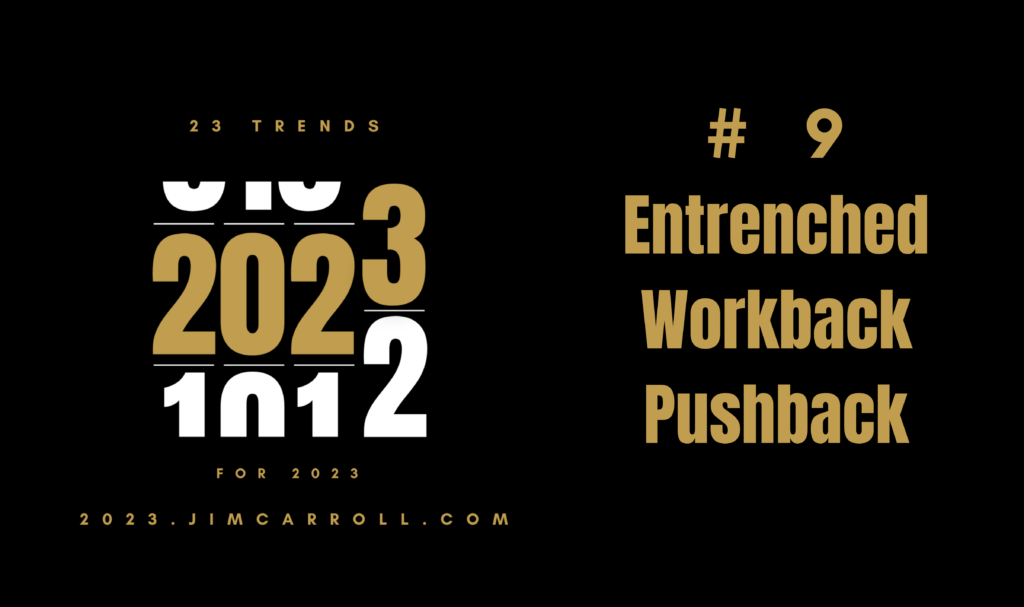
‘Workback pushback?’ It’s the phrase I’ve used to describe the pushback by employees on the idea of going back to the office full-time. Why is this an entrenched trend? Because it was already well underway prior to 2023. The global pandemic simply accelerated it.
This need not be complicated to understand:
- companies want people to go back to work – they’ve had enough
- many employees don’t want to go back – they like the freedom, lifestyle, and time saved
- with the acceleration of skills, it’s going to be more difficult for companies to get the specialized skills they need
- this means employees, not companies, are in control of this trend.
The Historical Context – The End of the Office Job
This trend is not new. I’ve been talking and writing about it for a long time. The pandemic has simply entrenched it.
Back at the end of the 90s, while the dot.com world was flying high, I was already busy speaking and writing about the future – with constant media interviews. In addition, I wrote for numerous Canadian publications – the Globe & Mail, National Post, Profit, and Marketing Magazine. Not only that, but I was busy with radio shows – I had an in-air show the global airline Air Canada (“dot. commerce with Jim Carroll“) and a monthly magazine column with the now-defunct Canadian Airlines (subsumed into Air Canada), called Time Travel.
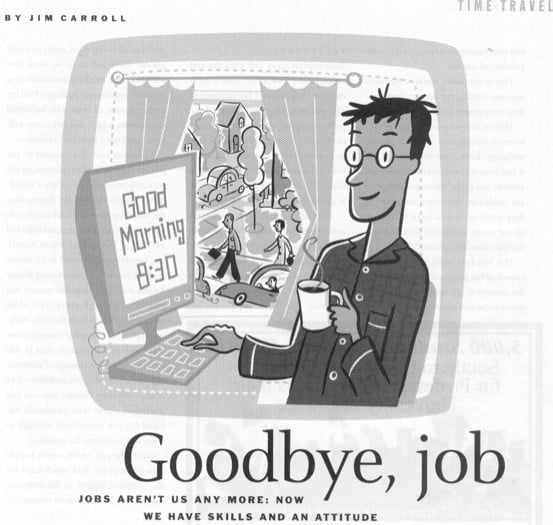
The latter was a fun column to write – I took on a subject, looked back in time, examined the present day, and cast my mind forward into the future. Looking back, most of the parts about looking forward were bang on as to where we are today, 20 years on. Have a read on what I wrote in 2000 which was already covering the essence of this trend, and think about it in the context of this whole ‘return to work’ issue.
Goodbye, Job
Jobs Aren’t Us Any More: Now We Have Skills and An Attitude
Canadian Airlines Magazine, April 2000
By Jim Carroll (PDF Version – GoodbyeJob)
Talk to some people today, and you’ll encounter individuals who are proud to say that they don’t have a job, a steady income, or any real idea of how they might earn a living a year from now. Ask them what they wear to work, and they might indicate pajamas. Ask them their overriding career goal, and they might indicate lifestyle. Ask them what they do, and they’ll tell you that economists have given them a number of different names. They’re temporary workers. Nomadic workers. Contingent workers. Independent contractors. Contract workers. Outsourced employees.
They’re the vanguard of the new economy, a world in which people no longer have a job for life. In fact, as we enter the 21st century, it’s become fashionable not to have a job, but rather, to have an attitude: “we’ve got skills that are needed by the corporate sector. If they want us, they’ll have to hire us on our terms, even if that means that we’ll work for them on a part-time basis.”
The last few years have seen the launch of the temporary economy, and the concept of the job and career promises never to be the same as a result.
Yesterday
Most experts agree that up until the mid-1800s, most people didn’t have a “job” – instead, they worked for themselves. The economy, largely agricultural and entrepreneurial, saw many individuals eking out a living on the family farm or in a small-scale business that served the local community, not unsurprising that most people worked within a few minutes walk of where they lived. After all, in the era of the horse and buggy, it was difficult to travel any further!
Yet all of this changed as the industrial revolution took hold. The most dramatic development occurred with Henry Ford and the invention of the automobile and the concept of the modern-day assembly line. Suddenly the workforce had mobility, allowing people to easily travel somewhere in order to go to work.
Not only that, but the modern manufacturing methods popularized by Ford led to the large-scale industrial enterprise, an organization that needed a lot of full-time employees in order to function.
Thus was born the concept of the job. By the 1950s, the transition in the economy was complete, with those who worked for themselves being the minority in an economy in which most people in the workforce held full-time jobs. The typical North American family was captured by the romantic notion of the Nelson family in the TV show Ozzie & Harriett. Here’s what the world was all about, a place where Dad wore a suit and went to work every day, while Mom stayed home with the kids, Ricky and David. Hollywood also typified the nature of the workplace in the popular movie, The Man in the Gray Flannel Suit, in which Gregory Peck played an office worker who caught the 8:05am train to work every day.
Unswervingly loyal to the company, he worked in a world in which no one was ever fired, and everyone had a job for life.
Implicit throughout this period was the emergence of a deal that was struck between the organization and the individual – give us your loyalty and work hard for us, indicated the company, and we’ll give you a job for life. People worked hard and came to believe in the company they worked for.
Today
Attitudes like that died, fast and furious with the recession of the 1990s.
It was a period that some have come to call the “white-collar recession.” For the first time, professional workers within offices found their jobs and careers at risk, as a particularly nasty wave of economic restructuring took place. The period of downsizing also led to a very significant change in the attitude that many people had towards the corporation.
Why? Because many individuals came to believe that the corporate world had come to break the social contract that had long existed in the previous 100 years. After all, people came to realize that the company they worked for might choose to let them go at any time, without warning. How could they possibly be loyal to the company, when the company no longer guaranteed them a job for life?
Such changing attitudes led to a rather unique situation, in which many of those who found themselves in a difficult situation decided not to seek another job in the corporate sector. Instead, economists began to notice that vast numbers of them were deciding to take care of themselves by establishing their own small company, often working out of their homes. Rather than seeking a job, they were setting themselves up to provide their skills and talents to the corporate sector on a part-time basis.
Of course, this line of thinking fit the mindset of the corporate world of the time. Many large organizations came to be reluctant to hire full-time staff, given the fact that severance packages had become rather extreme. They were all too eager to hire the contingent workforce that was appearing before their very eyes.
Tomorrow
There are those who believe that technology will help to enshrine the concept of the nomadic workforce, and as with everything, the Internet will play a key role.
Why? The reason is simple: the Internet is the foundation for an economy in which a growing number of nomadic workers are able to easily serve an ever-increasing number of clients located far beyond their local geographic area. The era of inexpensive global telecommunications is upon us, one in which e-mail, telephones, cell phones, faxes, and video conferencing allow people to work from anywhere, at any time. This means that many more people will choose to go the independent route, and because of the lifestyle implications, will choose to work from a home office.
Does this mean that we are doomed to a world in which once again, people are but a few minutes away from their place of work?
Not at all – indeed, those who work at home have come to realize that social interaction remains a key element of the working world. So even while they’ll work at home, they’ll also come quickly and frequently jump on the automobile of the 21st century – the jet airplane. With a client base that is global in nature, the nomadic worker will come to find that even though they don’t have a job, their job will continue to take them to far away and distant places.
The Workback Pushback Trend
In my own case, I started working from home a long, long time ago, and I’ve been here for 31+ years. For me, it’s about lifestyle, freedom, and flexibility. Lots of other people have discovered this through the pandemic, which is why I posted this as a trend two years ago.

I hit my home virtual broadcast and filmed a piece about trends to watch going forward – one of which I called Workback Pushback. It’s real, it’s going to be huge, and it’s going to be challenging!
The Ongoing Continuity of the Same Status
Nothing has changed really. Here’s what we’ve seen.
- companies want people to go back, and try all kinds of incentives to encourage people.
- people fight back.
- the story continues over and over again.
So we see articles like this one in the New York Times, which ran an article about the fact that people are showing reluctance to go back to work. These appear on a regular basis.
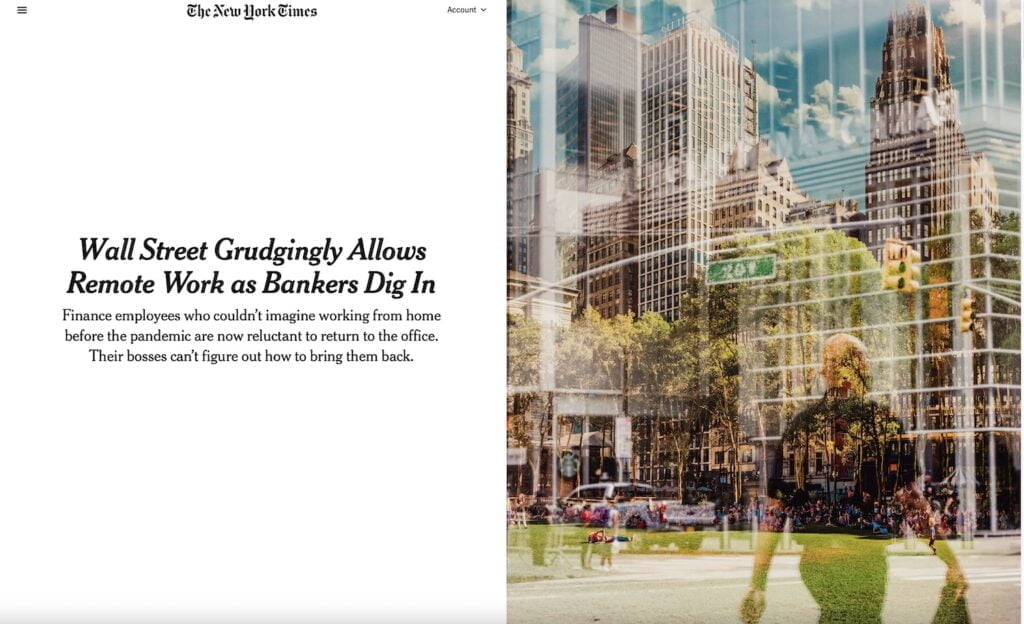
And yet, consider this – I just ran a quick news search on the phrase ‘return to the office,’ and there were literally dozens of articles in one month saying the same thing! Companies want people to go back; people don’t want to go back; and so we’re stuck in the same state!
Some are saying it’s a civic duty! Come back – it’s important for the city!
The recovery of Downtown activity levels from the COVID collapse in spring of 2020 has been discouraging. The Pittsburgh Downtown Partnership recorded a daily average of 87,117 people in the Golden Triangle – including residents, employees and other visitors – for the month of November. That’s a decline of more than one-third from the same month in 2019. And the trendline has flattened to a plateau.
This is simply not sustainable. People need to come back, or Downtown will wither
Every commuter who comes back isn’t just a potential sandwich-eater, bouquet-buyer or cocktail-drinker. They’re each one more point of contact for people who don’t work Downtown, to remind them of its amenities and to reassure them that it’s safe – and will get safer the more employees come back. And they’ll remind themselves of Downtown’s virtues and bring family and friends with them to catch a show or enjoy a meal.In other words, encouraging employees to return to the office – and accepting such an encouragement – is a civic duty.
Return to the office, for downtown’s sake
11 December 2022, Pittsburgh Post-Gazette
And yet there is no shortage of articles suggesting that people don’t want to come back:
CITY workers are ignoring calls from ‘C Suite’ executives for staff to come into the office for a minimum number of days each week, according to a new report.
Workers and managers in the financial and professional services sectors are instead employing their own “bespoke” working models that align with their specific operational needs, the LSE study says.The study – which is based on interviews with 100 workers in major companies including Goldman Sachs, Blackrock, Natwest, and PwC – suggested remote-first policies had no detrimental impact on productivity.
Those interviewed instead claimed flexible working policies have the potential to boost productivity significantly in providing greater efficiency at the team level.
The report, sponsored by some of the UK’s largest companies, argued firms that offer greater flexibility firms have an opportunity to reduce staff turnover related to burnout and stress.
It warned firms that fail to let staff work from home risk losing out in the battle for talent, as women in particular begin flocking to employers that offer flexibility.
City workers ignoring calls to return to the office
29 November 2022, City AM
And in fact, some simply refuse to come back.
* Lawyers at top UK practices are rebelling against plans to return to the office
* The revelation follows a major survey of hundreds of lawyers in the UK and USA
* Almost half of staff would quit if they had to work more than three days in office
More than a third of high-flying lawyers at leading London firms are ‘actively ignoring’ calls to stop working from home, it has been claimed.
A study by legal software firm BigHand found that 35 per cent of staff at top city firms and commercial practices were rebelling against ‘hybrid working policies’.
The scheme was meant to bring lawyers back into the office following almost two years of working from home during the pandemic.
But according to BigHand, a survey of 836 senior staff and solicitors at British and American practices found dozens of managers were ‘reluctantly… conceding to employee demands for flexibility’.
About 87 per cent of respondents claimed they enjoyed working from home while almost half of UK support staff – 48 per cent – warned they would look for another job if they were forced to work more than three days a week in the office.
Lawyers REFUSE to end WFH: More than a third of staff at leading law firms ‘actively ignore’ calls to return to the office
17 November 2022, Mail Online
Some employers are trying edicts to force people to come back, but that probably won’t; end well.
There is an emerging battle line between tech employers and their workers in the office.
Management wants them back in at least three days a week; the rank and file want to continue working from home. Something has to give.
The latest salvo came from Snap Inc. SNAP last month, which expects employees to spend at least 80% of their time in the office, according to an internal memo obtained by Bloomberg.
Snap Chief Executive Evan Spiegel says the policy, which starts in February, will help the company achieve “full potential” and allow workers to reach “our collective success.”
With companies contracting their workforces and pinching pennies amid a wobbly economy, companies increasingly see onsite workers as essential to maximizing revenue. Indeed, market researcher IDC predicts large companies that “deploy reactive and tactical hybrid work models” will suffer a revenue loss of 20% in 2024 because of job attrition and underperforming teams.
Salesforce Inc. CRM CEO Marc Benioff has pushed back on the notion, saying in June that back-to-office mandates would “never work.” And a recent report from Dr. Grace Lordan of the London School of Economics claims, “Firms that demand their employees are in the office for no reason will lose out on diverse talent pools.”
Snap and other tech companies have a new edict for employees: Return to the office
7 December 2022, MarketWatch
And yet it is all about skills:
High-profile CEOs like Twitter owner Elon Musk might be mandating a return-to-the- office, but the number of high-paying remote jobs continues to grow.
The share of posted jobs that pay more than $100,000 per year and offer remote work has reached 36%, according to high-paying careers site Ladders Inc. That’s up from 18% at the end of 2021.
The number of remote-work opportunities continues to grow as professionals’ desire for schedule flexibility and work-from-home options persists. It’s a trend that’s affecting strategies not just for employers, but for communities, as well. Now, cities across the country are offering incentives for remote workers to move there as part of a growing economic development strategy.
Since the pandemic began, data scientists from Ladders have been tracking remote-work data from North America’s largest 50,000 employers, not just those with listings on Ladders. Prior to the pandemic, only about 4% of high-paying jobs were available remotely.
“This year, we’ve seen a massive influx of ‘return to work’ policies, creating discourse around the future of the office and work in general,” said CEO Dave Fisch, in a press release announcing the findings. “What we’re seeing is a significant increase in remote jobs yearly and monthly, and there’s no sign of slowing down.”
Overall, the percentage of permanent remote work jobs has soared since the pandemic began. In the third quarter of 2019, just 3.71% of high-paying jobs were remote. By the end of 2020, that number grew to 7.3% and has only continued to rise.
What return to the office? High-paying remote jobs continue to soar
17 November 2022, Triad Business Journal
And so companies end up giving in:
General Motors is stepping back a bit on a return-to-work policy it revealed to salaried employees last week.
On Tuesday, CEO Mary Barra sent out a note to the salaried workforce offering an apology of sorts for the timing of putting out a new policy late in the day Friday saying that employees would have to return to working in the office three days a week.
She said now that GM’s plan still will include a more regular, in-person presence, but it will not implement any changes to its return-to-the-office policy this year as the company continues to listen to employee feedback. The plan still will ask employees to work in-office three days each week.
GM steps back on return to the office; After worker backlash, Barra says feedback will be sought
28 September 2022, The Detroit Free Press
I fully expect this dynamic to play out well into the future. People aren’t going back. Particularly in-demand, skilled workers. Attitudes are entrenched!
The Context? The Snowboard Dude from 2004!
To close. consider this news article which appeared when I spoke about this issue in Belgium earlier this year.
Article: Jim Carroll: ‘All recruiters need to become futurists’
Renowned futurist Jim Carroll knows a fair bit about trends and innovation. During the E-Recruitment Congress in Belgium, he delved into why recruiters need to become futurists.

Few people get into as many interesting places as futurist Jim Carroll. The Ontario, Canada-native has made a living advising companies such as Disney, Nikon, Volvo, Pfizer — and many others — on anything related to trends and innovation. His keynotes tend to be an experience. He joined the 2022 edition of the E-recruitment Congress from his remote video studio, built into the basement of his house, he started by speaking about all the changes that have occurred during the past pandemic-filled years.
“COVID has accelerated the speed of change. Mainly virtual change.”
“You simply couldn’t get away from virtual”, he said as his green screen enabled him to visibly appear from New York City and a Belgian beach. “These past years have completely changed our relationship with the world, employees, and employers. I’ve spent a lot of time on a lot of stages around the world outlining what happens in the world where we need to think big, start small and scale fast. But COVID has accelerated the speed of change. Mainly virtual change”, Carroll said, as he traveled back to his virtual studio.
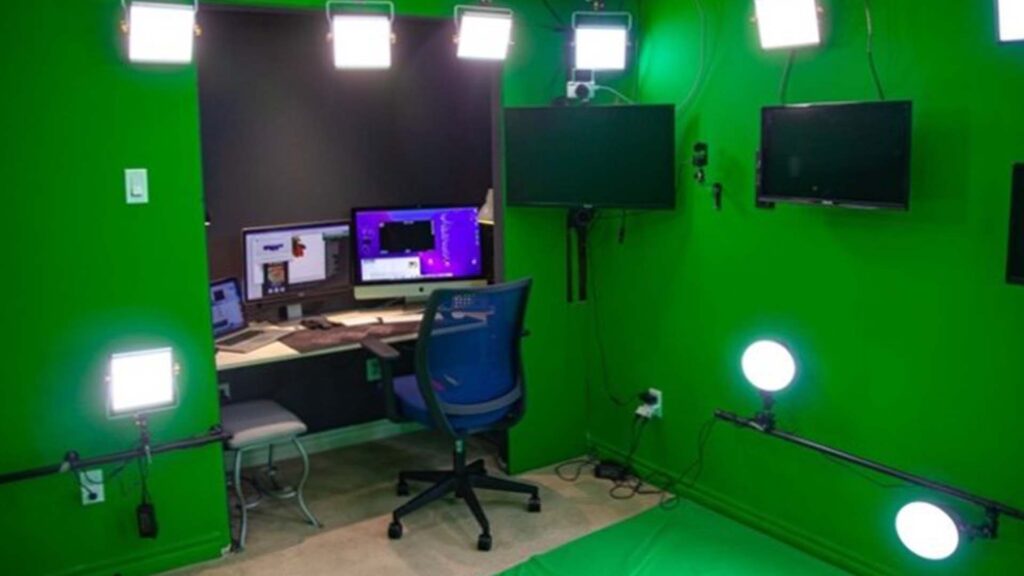
Then the curtains unravelled from the stage in Ostend, Belgium. Several green-screens appeared out of the darkness. There he stood: Jim Carroll.
Then the curtains unraveled from the stage in Ostend, Belgium. Several green screens appeared out of the darkness. There he stood: Jim Carroll. Not from his house in Canada — but on the actual stage. Proving to an audience of recruiters and talent leaders, who had initially perhaps felt disappointed Carroll wasn’t there physically, that technology has changed fast.
‘Digital presence matters’
“In case you didn’t realize, the world is now a fundamentally different place”, Carroll continued. “We’re in a situation where companies that not yet exist will build products not yet conceived, using materials not yet invented. How are you going to recruit people for that reality? The future is that I can’t keep up with the change of trends. Science-fiction ideas are real before you realize it. In 2020, in as little as 6 months, we saw 10 years’ worth of change.”
“How are you going to be an employer of choice if you don’t have the digital presence?”
“A lot of the excuses disappeared when COVID struck”, Carroll said. “Because ‘get it done’ became the rallying cry. Now the future belongs to those who are even faster due to digital transformation. You all thought I was in Canada. The way we present ourselves to the world, the image we put out there, matters. But how are you going to be an employer of choice if you don’t have a digital presence? How can you attract a generation that is completely digital in everything they do?”
Your boss thinks you have no long-term vision if you don’t turn your camera on during Zoom meetings.”
It is all part of what Carroll sees a greater digital good. “Your boss thinks you have no long-term vision if you don’t turn your camera on during Zoom meetings”, he said. “They think if you’re not engaged virtually, then you’re not a good employee. That’s why digital presence matters. You need to show digital professionalism. I always use the same mantra: think big, start small and scale fast.”
‘Recruiters need to become futurists’
Many recruiters currently live in the reality that has been dubbed The Great Resignation, The Great Re-Shuffle — or something else that has been less than great for getting people into jobs. “It’s nothing new”, Carroll said. “COVID simply accelerated a trend that was already taking place. The future happens slowly, and then all at once. You need to be prepared for that. Change is happening so quickly, that you need to recruit people for jobs you don’t yet know exist. You need to be prepared for that reality yesterday.”
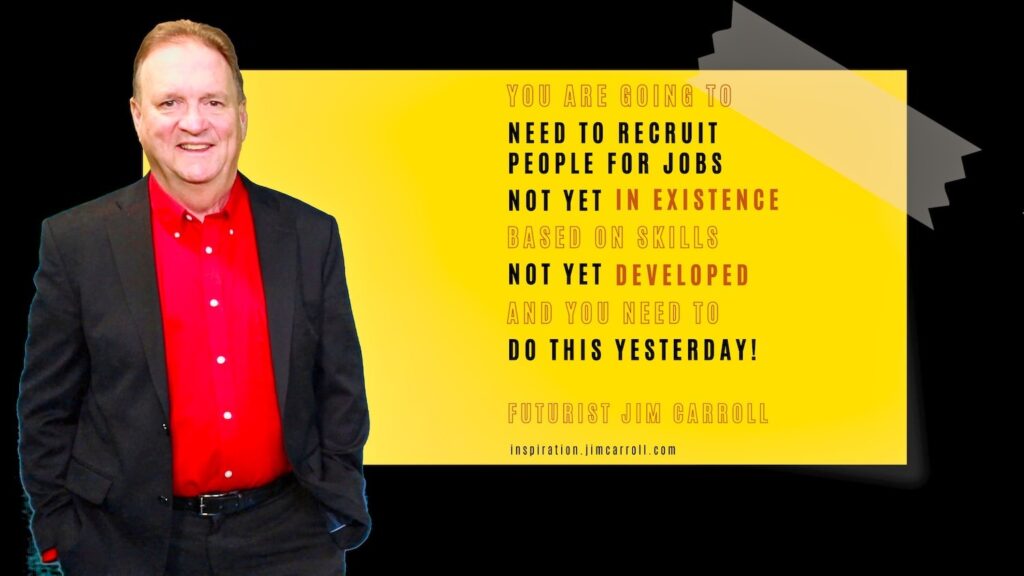
“Change is happening so quickly, you need to recruit people for jobs you don’t yet know exist.”
“You need to become futurists”, Carroll continued. “You need to learn how to predict the future when it comes to rapid knowledge obsolescence and rapid knowledge emergence. To put it into context: the medical knowledge used to double every eight years; that number is now down to 78 days. You need to deliver knowledge for people who don’t yet know they need that knowledge.”
“Careers are disappearing and new ones are popping up. How will you recruit for those jobs?”
Whether you’ll source for virtual farming infrastructure managers, robotic pharmaceutical therapy monitors, water footprint analysts, or drone helicopter insurance crop risk managers — you need what Carroll calls ‘just-in-time knowledge’. “We’re amidst a big evolution of new skills and trades. Careers are disappearing and new ones are popping up. How will you recruit for those jobs?”
‘People might simply not want to be recruited’
But as scarcity persists, recruiters are still chasing those they need to recruit. Therein lies another lesson, according to Carroll: they may simply not want to be recruiters. “I’m 63, and my generation defines itself based on what we do for a living. When I asked a 22-year-old snowboarder kid why he wasn’t interested in a job opportunity, he gave me a simple answer: ‘Because you’re messing with my powder, dude.’ The fact is: they don’t define themselves by their job, they define themselves in what they like to do.”
“I’m 63, and my generation defines itself based on what we do for a living.”
In that context, everything is transactional, Carroll said. “They will simply move to any position that will give them a better monetary reward. Many of them are already thinking of a new job on their very first day. More and more see the added value of self-employment. Moreover, they think 2 to 5 years in an organization is a long-term career. Does someone give them a better offer? They’re gone…”
“They don’t care about the name of the company. They want to enjoy what they do.”
So where does employer branding fit in, according to Carroll? “Your corporate brand has had to change and evolve in recent years. You could call your organization‘ digital’ and ‘hybrid’, but when you want everyone back in the office, you’re not digital, or hybrid. From that point-of-view, they don’t care about the name of the company. They want to enjoy what they do. If they’re on TikTok, go create short, sharp shots of insight there. A digital presence is everything.”
‘They don’t want to go back to the office’
As leadership discussions take place about adopting full-time remote, hybrid, or just back-to-the-office models, Carroll sees a fundamental shift in what the younger generation wants. “They have no desire to go back into the office because they’ve tasted freedom. They have no desire to be part of the traditional workforce. We have leaders who want us to go back to 2019. That is just not going to happen.”

“The younger generation has no desire to go back into the office because they’ve tasted freedom.”
“I think the final result will have to be some type of hybrid in lieu of the workback pushback”, Carroll continued. “I think the truth is found in the snowboarder, who gets up every morning and goes for a run. Then puts in four solid hours, goes for a walk during the afternoon — and puts in another solid three hours. That’s the new reality. Meetings and events can be used as corporate team-building exercises, but the corporate culture will have changed — and evolved.”
“It’s all about contract work, part-time relationships, and external partnerships. This is not a new trend.”
In conclusion, Carroll recalls being stunned when he read a New York Times article in 1987, which predicted a future wherein organizations would become smaller and become something fundamentally different. “Fast forward to today’s economy: organizations are going to go forward with a smaller employee footprint”, Carroll continued. “They’re expanding and contracting as necessary. It’s all about contract work, part-time relationships, and external partnerships. This is not a new trend.”




GET IN TOUCH
Jim's Facebook page
You'll find Jim's latest videos on Youtube
Mastodon. What's on Jim's mind? Check his feed!
LinkedIn - reach out to Jim for a professional connection!
Flickr! Get inspired! A massive archive of all of Jim's daily inspirational quotes!
Instagram - the home for Jim's motivational mind!